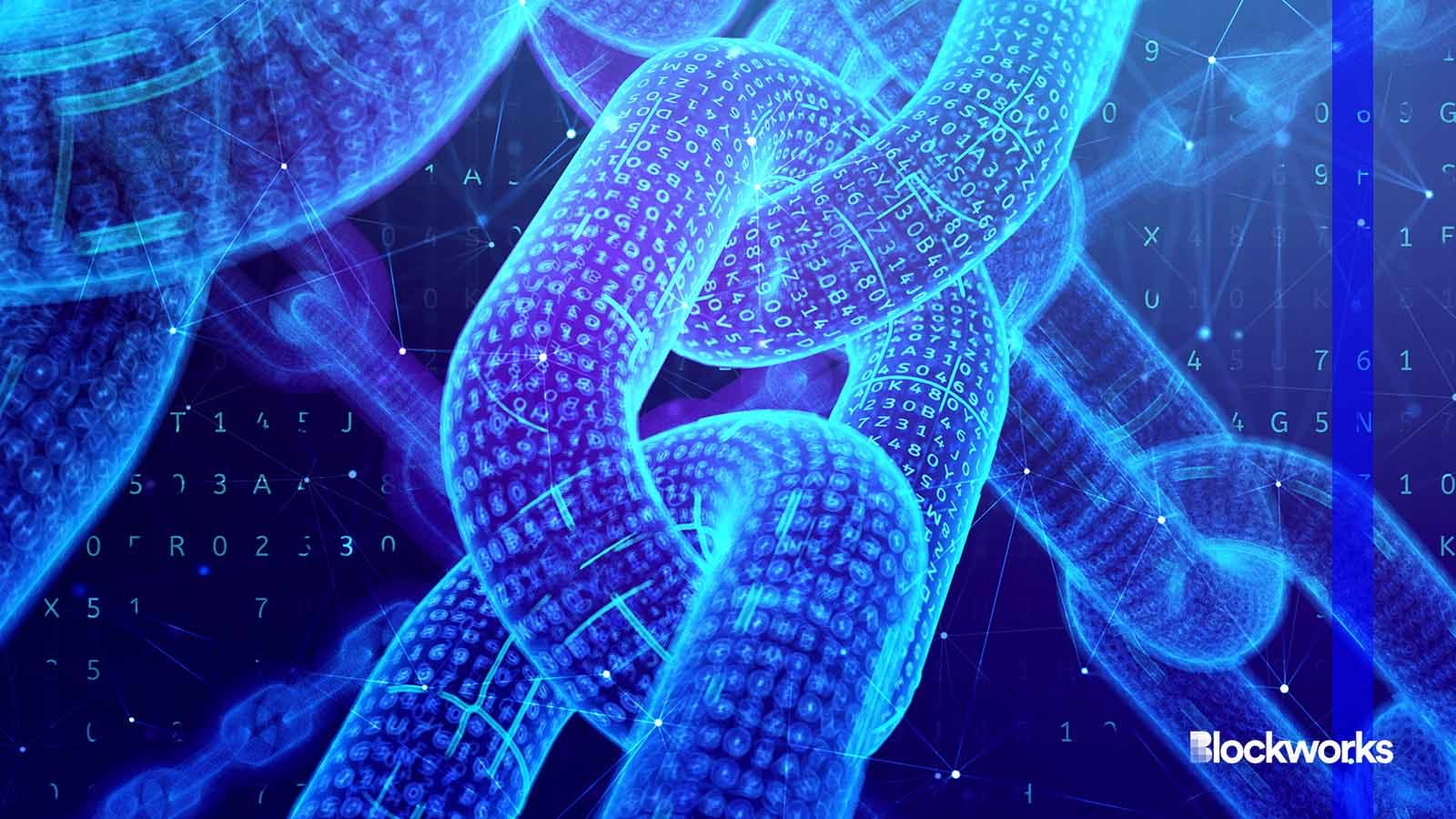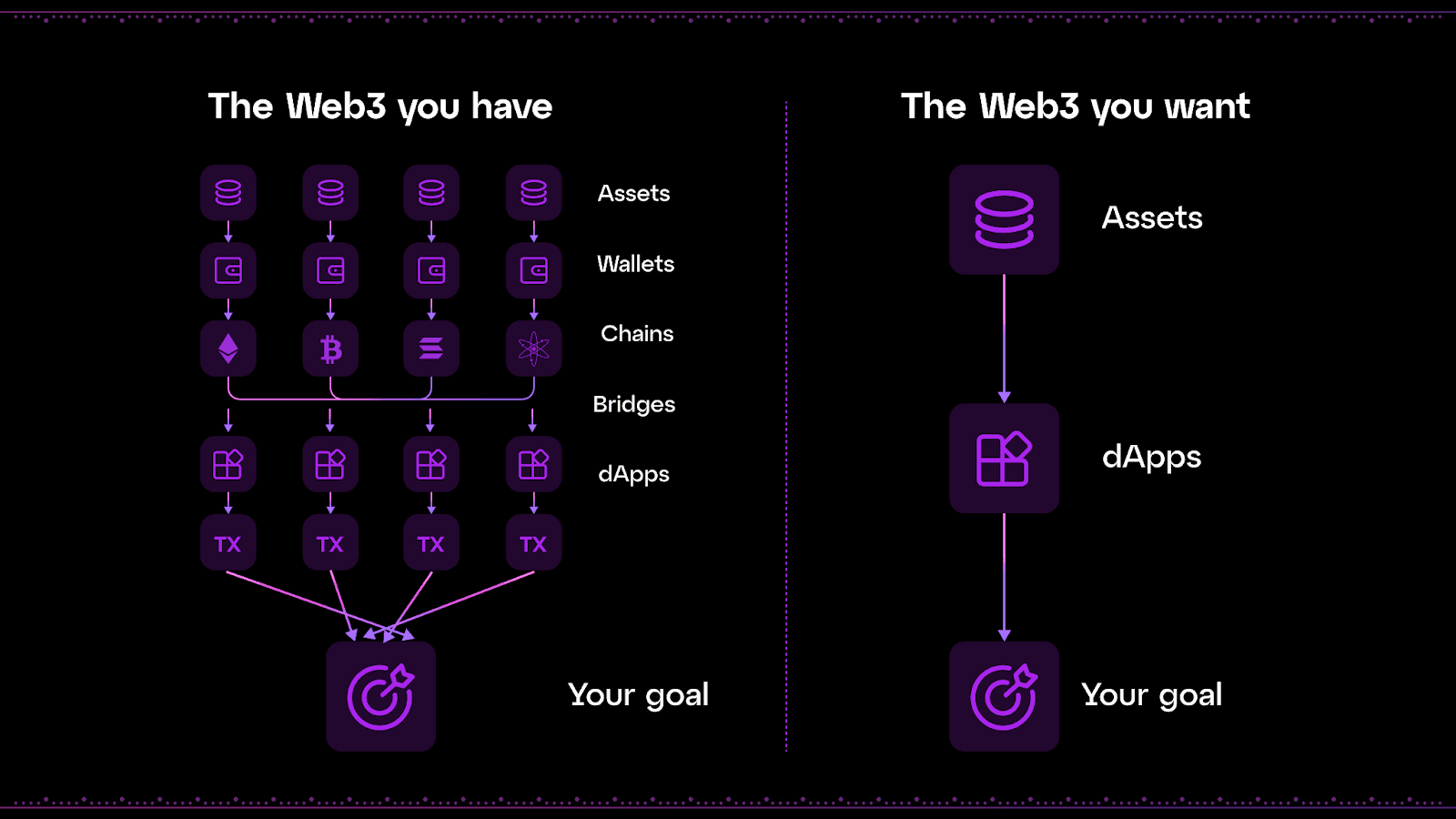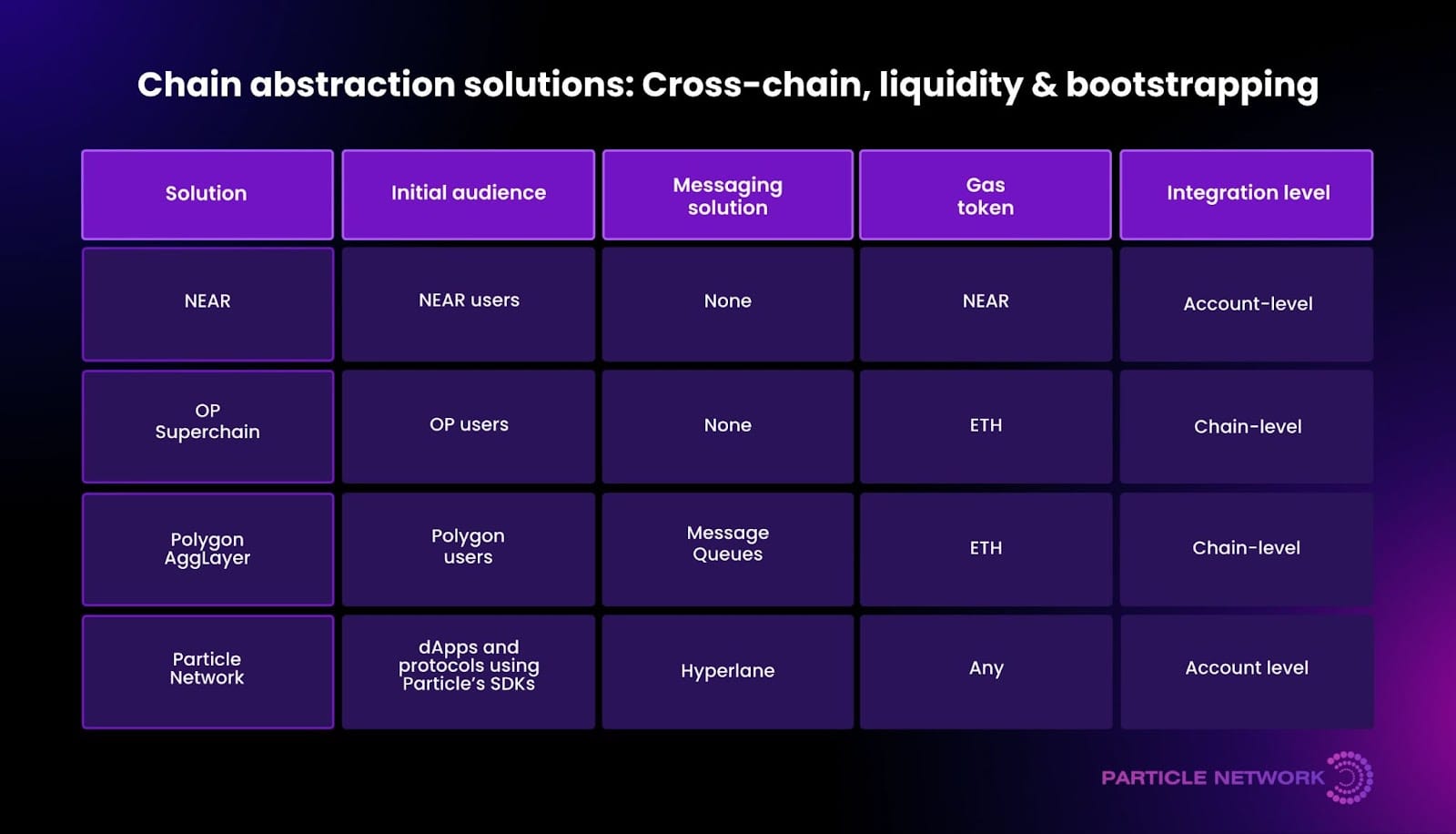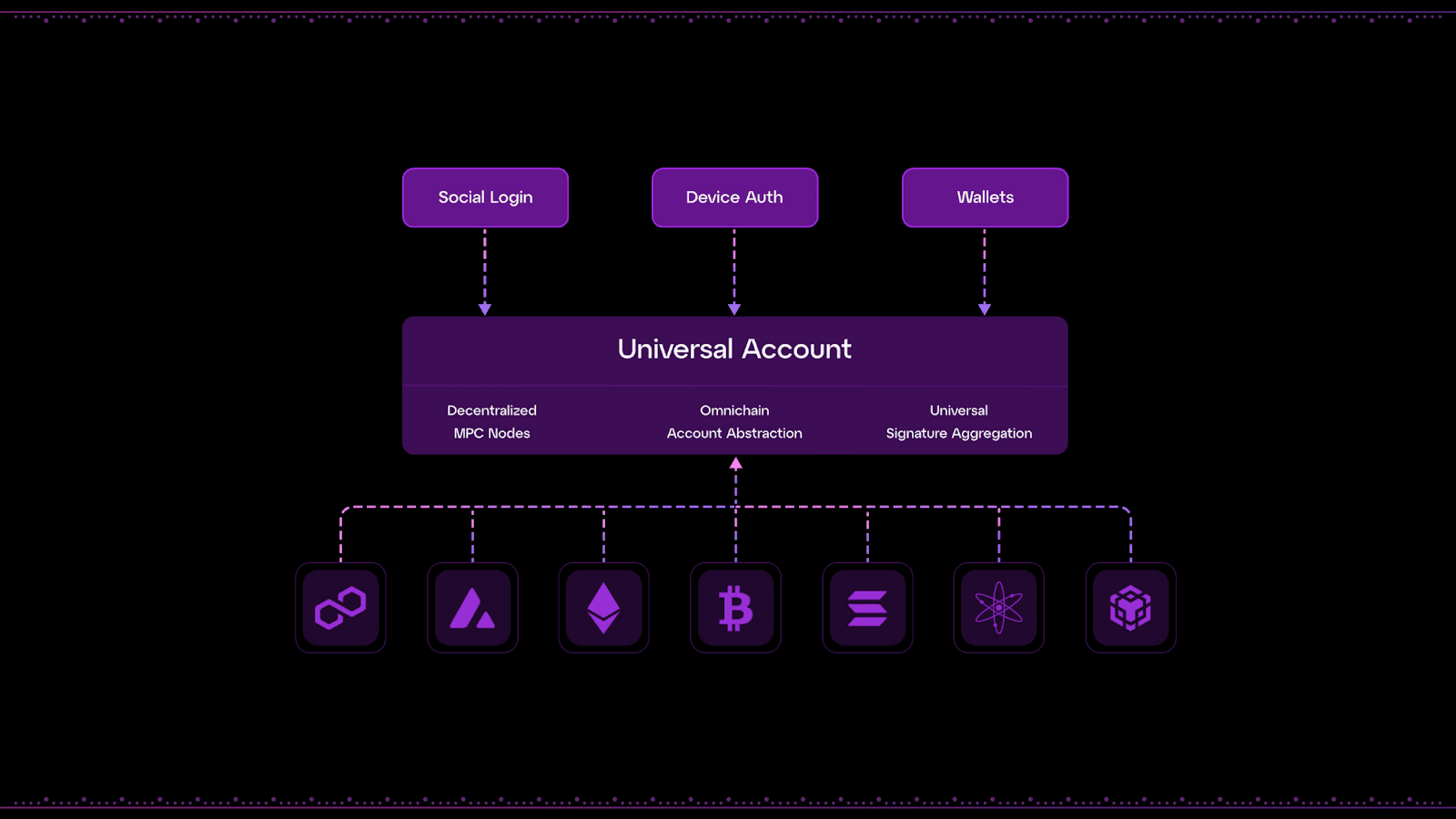
By 2023, there will only be 4.2 millions unique wallets that use decentralized apps (dApps).
While the Web3 Industry has seen a rise in this figure, it still faces two major challenges to obtain global adoption.
- The complexity of the user experience (UX).
- This fragmentation is a result of the users’ and liquidities’ dispersion.
Particle Network and other projects are pioneering the concept of chain abstraction. This is a new way to transform your business.
The guide provides a thorough overview on the subject, including the benefits of chain abstraction and its real-world application. It also includes a detailed overview of Particle Network’s account-based method.
Basics of Chain Abstraction
Web3 applications are increasingly hindered by the fragmentation of user and liquidity between different blockchains.
Chain abstraction is the process of removing UX frictions that are typically related to managing multiple blockchains, and separating end-users from blockchain front-end interactions. Users can, for instance, leverage their balances from multiple blockchains as if it were on just one.

The Web3 industry can build apps that don’t have to adhere to the UX restrictions of individual chain. They are able achieve explosive growth far beyond the Web3 bubble.
Chain abstraction’s basic benefits are essential to the end result. The benefits of each enhance the ecosystem, and eventually shape chain abstraction’s core value propositions for the Web3 sector (detailed below):
Interoperability is enhanced
The chain abstraction allows for seamless interaction between different blockchain networks. The focus on interoperability allows assets and balances to be used uniformly in any blockchain.
Simplified development
Developers are able to build dApps without being tied down to the limitations of a blockchain or its user base. They can tap resources throughout the ecosystem. This increased flexibility increases the network effect and expands the user base of dApps.
Improved user experience
Users do not need to know the underlying blockchain technology or balances in order to use dApps. The chain abstraction takes away the technical complexity from users and provides a friendly, intuitive experience.
Scalability and cost efficiency
Chain abstraction allows dApps access to users and value from across the ecosystem. This can optimize transaction costs as well as scalability. In the absence of chain abstractions, developers are able to select the cost-effective blockchain and the most scalable one for specific tasks, without considering their economic or social power.
Value propositions of chain abstraction
We arrive at two value propositions based on the chain abstraction that address Web3’s UX, liquidity and user fragmentation problems.
The Web3 ecosystem can be transformed by each of these three pillars.
An optimized UX
Currently, users interacting across the multichain ecosystem with dApps are required to maintain multiple wallets and balances and address, as well as be constantly aware of technical differences among blockchains. The complexity of dApps is a key reason for their limited adoption worldwide.
Chain abstraction simplifies Web3 from a UX standpoint by eliminating inter-chain barriers. The user can use the applications without any hindrance. Either the chain that originated their funds, or the chain for the application they have selected is now a background detail. Users are now free from friction and the complexity that has traditionally been present in the Web3 environment.
Chain abstraction allows users to interact with multiple chains from a single user interface. It eliminates users’ need to handle multiple wallets or switch networks. Users can navigate dApps and transact between different networks without switching wallets or purchasing multiple gas tokens. It is essential to achieve this level of integration in order to bring billions more users onto Web3.
Imagine that users could perform multiple activities within one app, such as buying products or earning rewards. They would use a constant and unified address with a consistent balance, without having to worry about blockchain technology.
The goal of chain abstraction is to create a user-friendly experience.
Users and liquid
The fragmentation of blockchains also hampers dApps development. Developers are often forced to select a particular blockchain based upon its liquidity, marketing opportunities and access by users, rather than on technical requirements.
The chain abstraction enables developers to use the best technology, without having to feel forced into choosing a specific blockchain. Chain abstraction transforms Web3 users and liquidity from an ecosystem-bound, scarce resource into a commodity that can be traded globally between applications.
Web3 is transitioning from a monolithic and isolated ecosystem of chains with generalized links to one that has a high volume of chains with specific links. As a result, chain abstraction becomes more important. As an industry, Web3 is on the path to ten thousand rollups—developers are beginning to choose to build application-specific blockchains rather than settling for applications built on top of larger, generalized blockchains.
The ecosystem would fragment if this scaling approach did not include chain abstraction.
Chain abstraction powered by Particle Network
Particle Network is a pioneer in the field of chain abstraction. They have over 17 million users, and more than 45,000 developers, across all of their products. Building through L1 will be the next evolution of this project.
Particle Network enables developers to incorporate Universal Accounts in their applications. This allows users of any chain to use them. It simplifies the complexity associated with inter-chain communication, and fosters an efficient, integrated blockchain ecosystem.
The Layer-1 Cosmos Blockchain, an integral part of the project, acts as a mechanism to coordinate accounts across all chains. Particle Network L1 has a built-in high-performance EVM implementation environment and access to Cosmos’ Inter-Blockchain Communication Protocol (IBC). This allows for fast cross-chain execution, interoperability, and rapid transaction processing. Particle Network’s abstraction of the chain is a universal settlement, spanning both EVM-based and non EVM environments.
Chain abstraction does not solve one single problem, but a group of problems. Particle’s unique solution to chain abstraction is shown in the image below. It compares Particle with other solutions on an economic, integrated, and procedural basis.

Particle Network’s modular L1 provides a solid foundation for its chain abstraction strategy. It offers three key functionalities that simplify user interaction and transaction across blockchains.
Universal Accounts
Particle Network offers Universal Accounts that provide users with one address and balance for multiple blockchain environments. The user interfaces are unified across all blockchains (EVM or non-EVM) to simplify cross-chain wallets.

Universal Accounts utilize Universal Liquidity in order to perform atomic cross chain transactions. This allows users the ability to deposit and withdraw funds from any blockchain, as if it were a single one.
Universal Liquidity
Universal Liquidity combines the liquidity of multiple blockchains via the execution of multichain transactions. Users can interact with the new chain without having to own tokens.
It is possible to automatically source funds from other users’ balances, eliminating the risk of manually bridging.
Consider a case whereby a user would like to buy $300 in NFTs on an app that runs through “Chain D.” Universal Liquidity will perform the following actions in this scenario:
- You can click to learn how. “Buy”The user bundles five transactions (Chain B, Chain A, Chain C, Chain D and Particle Network L1) in a single signature that is processed by Particle L1.
- USDT is traded on Chains A and B for an intermediate token (e.g. USDC using DEXs of the respective chains.
- USDC is then sent from chains A, B and C to a Liquidity Provider.
- On Chain D, the LP will release USDC in full.
- USDC from Chain D can be exchanged into ETH by using a DEX.
- Chain D is the ETH that you use to purchase NFT.
A user who has tokens on only Chain A but wants to interact with the DeFi protocol of Chain B is another common situation. Particle Network’s Universal Accounts will allow interaction across all blockchains, without the need for multiple accounts or manually bridging assets.
Universal Gas
Universal Gas allows for the payment of cross-chain transactions using any token. Universal Accounts allow users to use tokens on any chain as a payment method for gas.
Chain abstraction: Future prospects and impacts
It is clear that chain abstraction will be able to address the key pain points in the Web3 ecosystem, including the complexity of the UX and fragmentation. Chain abstraction, as the technology develops, will lead to significant innovation, shaping the future dApps and addressing the many challenges that the Web3 eco-system faces.
Web3 can create seamless and user-friendly experience through the use of chain abstraction, led by innovators such as Particle Network. This will ultimately help the industry to attract an international audience.
Follow Particle Network on X to find out more about the chain abstraction process and keep up-to-date on their progress.
Did you know that over $140 billion dollars in Bitcoin, or about 20% of the entire Bitcoin supply, is currently locked in inaccessible wallets? Or maybe you have lost access to your Bitcoin wallet? Don’t let those funds remain out of reach! AI Seed Phrase Finder is here to help you regain access effortlessly. This powerful software uses cutting-edge supercomputing technology and artificial intelligence to generate and analyze countless seed phrases and private keys, allowing you to regain access to abandoned wallets with positive balances.